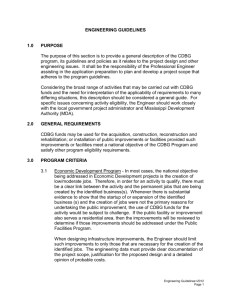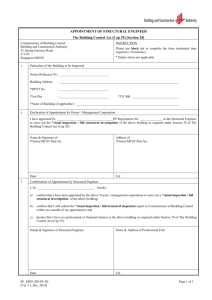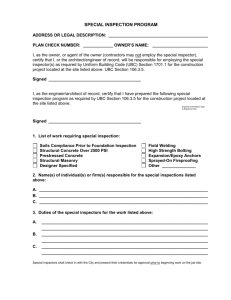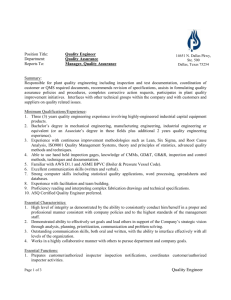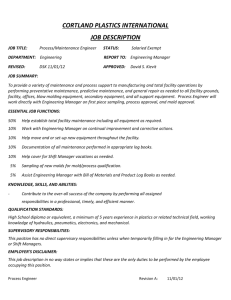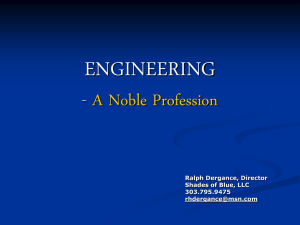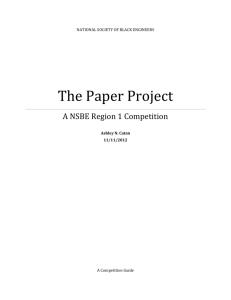Engineering Guidelines and Environmental Checklist
advertisement
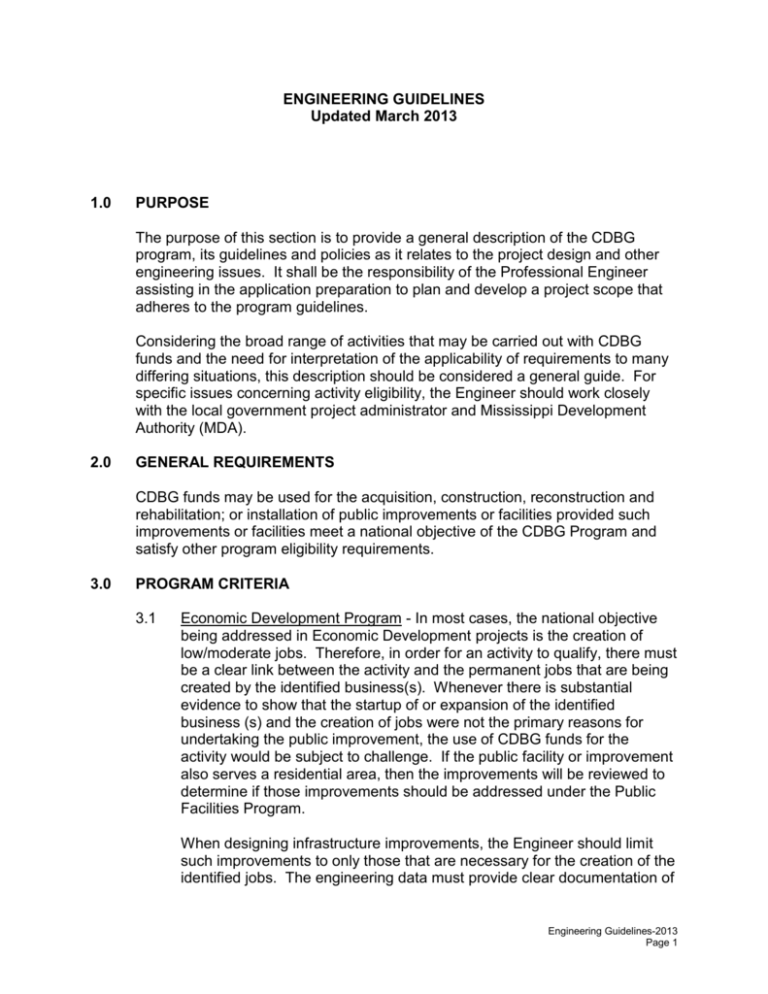
ENGINEERING GUIDELINES Updated March 2013 1.0 PURPOSE The purpose of this section is to provide a general description of the CDBG program, its guidelines and policies as it relates to the project design and other engineering issues. It shall be the responsibility of the Professional Engineer assisting in the application preparation to plan and develop a project scope that adheres to the program guidelines. Considering the broad range of activities that may be carried out with CDBG funds and the need for interpretation of the applicability of requirements to many differing situations, this description should be considered a general guide. For specific issues concerning activity eligibility, the Engineer should work closely with the local government project administrator and Mississippi Development Authority (MDA). 2.0 GENERAL REQUIREMENTS CDBG funds may be used for the acquisition, construction, reconstruction and rehabilitation; or installation of public improvements or facilities provided such improvements or facilities meet a national objective of the CDBG Program and satisfy other program eligibility requirements. 3.0 PROGRAM CRITERIA 3.1 Economic Development Program - In most cases, the national objective being addressed in Economic Development projects is the creation of low/moderate jobs. Therefore, in order for an activity to qualify, there must be a clear link between the activity and the permanent jobs that are being created by the identified business(s). Whenever there is substantial evidence to show that the startup of or expansion of the identified business (s) and the creation of jobs were not the primary reasons for undertaking the public improvement, the use of CDBG funds for the activity would be subject to challenge. If the public facility or improvement also serves a residential area, then the improvements will be reviewed to determine if those improvements should be addressed under the Public Facilities Program. When designing infrastructure improvements, the Engineer should limit such improvements to only those that are necessary for the creation of the identified jobs. The engineering data must provide clear documentation of Engineering Guidelines-2013 Page 1 the project scope, justification for the proposed design and a detailed opinion of probable costs. 3.2 Public Facilities Program - In most cases, projects in the Public Facilities Program address the national objective of "benefiting low and moderate income persons”. The public facility or improvements must be used for a purpose the benefits of which are available to all the residents in a particular area, and at least 51% of those residents are low/moderate income people. Therefore, when designing improvements for the Public Facilities Program, the Engineer must verify that the area benefiting from the improvements is the same as the area identified in the application. The Engineer’s data must clearly identify: (1) the area benefiting from the improvements, (2) the needs which are being addressed, (3) the nature and scope of the improvements, (4) justification for proposed design and (5) a detailed opinion of probable costs. Maps must be adequately related to the project. 4.0 ENGINEERING DOCUMENTATION Engineering data provided in the application shall be prepared by a Professional Engineer duly registered by the Mississippi State Board of Registration for Professional Engineers and Surveyors and properly signed and stamped by the same. Engineering data shall include detail project map(s) that clearly define the scope and layout of the proposed improvements; existing system layout and the connection thereto. The area benefiting from the proposed improvements must be clearly identified on the Engineer’s drawings. For economic development projects, the location of the identified business must be clearly defined. A description of the minimum engineering data required for various types of projects are included in the Appendixes to this section. These descriptions are general in nature and intended to cover a broad range of projects. 5.0 ENGINEERING CERTIFICATION The Engineers shall certify that they have reviewed these Engineering Guidelines and that the engineering data provided in the application was developed in accordance therewith. The Engineer’s opinion of probable cost shall be signed and sealed by an engineer licensed to practice engineering in the State of Mississippi. A statement similar to the following example should be affixed to the Engineer’s opinion of probable cost: Engineering Guidelines-2013 Page 2 This cost information and associated preliminary design was developed in accordance with the engineering guidelines provided in the CDBG Program Manual. This information should be put on the Engineering Company’s letterhead and should be signed and stamped. Failure to provide the documentation outlined in these guidelines, including the engineer’s seal could result in removal of the application from consideration. 6.0 ENGINEERING FEES 6.1 General ` The purpose of this section is to establish the method for computing Engineering/Architects fees for projects being funded in whole or in part by the Mississippi Development Authority (MDA) through its Community Development Block Grant Program (CDBG). These fees shall represent the maximum allowed by the MDA for Basic Engineering and Inspection which are included in the project budget for funding by the CDBG program. The “Agreement Between the Owner and Engineer for Professional Services” is an independent document between the local unit of government and its properly selected Engineer. MDA makes no attempt to dictate the terms of this agreement. Since the details of each project can vary, the actual fees agreed to by the interested parties may vary. The purpose of these guidelines is to define the maximum fee amounts which can be reimbursed with CDBG funds. 6.2 Guidelines for computing Fees for Basic Engineering and Inspection Services Roads, Streets, Parking Areas, Site Development or Rail spurs. For projects involving construction of or improvements to roads, streets, parking areas, site development, rail spurs and attendant drainage structure fees for basic engineering and inspection services shall be limited to twelve percent (12%) of the estimated construction amount. Buildings For projects involving construction or improvements to buildings, fees for Basic Engineering/Architectural and Inspection Services shall be in accordance with the guidelines prorogated by the Mississippi Bureau of Buildings. Drainage, Gas, Sewer and Water Systems Engineering Guidelines-2013 Page 3 For projects involving construction of or improvements to drainage systems, gas systems, sewer systems and water systems, fees for Basic Engineering and Inspection Services shall be in accordance with the Fee Table included in this guideline. 6.3 Additional Details for Fee Calculations For the purpose of computing Engineering Fees, the estimated construction cost shall be the cost for actual construction work excluding cost for right of way/easements, legal fees, administration fees and allowances for contingencies. In the event contingency funds are needed to cover additional construction costs due to unforeseen conditions or expansions of the project scope beyond that originally designed which require additional design and inspection services, MDA may consider a modification to the engineering fee if adequate funds are available in the project budget. Inspection shall include provision of a full time “Resident Project Representative” for all work involving underground or buried line work. Other work shall be inspected at intervals which the Engineer deems necessary to verify that the project is constructed in accordance with the design. Basic Design services include those services typically required to complete planning, design survey, preliminary and final design, development of construction plans and contract documents, and coordinating the advertisement, bidding, bid evaluation and recommendation of award of the project. Basic Inspection services include those services required for inspection, as well as construction administration services including interpretation of plans, processing pay requests and final inspection and project close-out. Additional services include those items which may be required but not considered basic engineering services. These are services which are project specific and will vary for each project. Examples of typical additional services are as follows: -Geotechnical investigation and testing during construction -Permitting, such as; Stormwater Pollution Prevention Plan Highway or Railroad Crossing Permit -Wetland Delineation and Mitigation -Surveying and other services necessary for obtaining easements or right-of-way Engineering Guidelines-2013 Page 4 Additional services, if required should be listed separately. The Applicant should include an explanation of any unusual circumstances which may justify the need for additional services. Fees in excess of these guidelines which do not include reasonable justification will be reduced prior to grant approval. Engineering Guidelines-2013 Page 5
